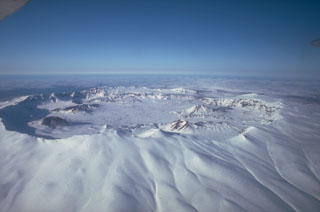Report on Okmok (United States) — August 1983
Scientific Event Alert Network Bulletin, vol. 8, no. 8 (August 1983)
Managing Editor: Lindsay McClelland.
Okmok (United States) Possible eruption plume on satellite imagery
Please cite this report as:
Global Volcanism Program, 1983. Report on Okmok (United States) (McClelland, L., ed.). Scientific Event Alert Network Bulletin, 8:8. Smithsonian Institution. https://doi.org/10.5479/si.GVP.SEAN198308-311290
Okmok
United States
53.43°N, 168.13°W; summit elev. 1073 m
All times are local (unless otherwise noted)
Images from the NOAA 7 polar orbiting satellite at 1816 on 8 July showed an elongate plume extending approximately 100 km S from Okmok. Analysis of infrared data yielded a plume temperature of -25°C, corresponding to an altitude of 6.3 km. The plume was not visible on imagery returned 12 hours earlier and later. There were no other reports of activity at Okmok during this period. Umnak Island is not densely populated, but aircraft frequently fly near the volcano.
Geological Summary. The broad, basaltic Okmok shield volcano, which forms the NE end of Umnak Island, has a dramatically different profile than most other Aleutian volcanoes. The summit of the low, 35-km-wide volcano is cut by two overlapping 10-km-wide calderas formed during eruptions about 12,000 and 2050 years ago that produced dacitic pyroclastic flows that reached the coast. More than 60 tephra layers from Okmok have been found overlying the 12,000-year-old caldera-forming tephra layer. Numerous satellitic cones and lava domes dot the flanks of the volcano down to the coast, including 1253-m Mount Tulik on the SE flank, which is almost 200 m higher than the caldera rim. Some of the post-caldera cones show evidence of wave-cut lake terraces; the more recent cones, some of which have been active historically, were formed after the caldera lake, once 150 m deep, disappeared. Hot springs and fumaroles are found within the caldera. Historical eruptions have occurred since 1805 from cinder cones within the caldera.
Information Contacts: M. Matson, NOAA/NESDIS; T. Miller and M. E. Yount, USGS, Anchorage.

